Telangana SCERT 8th Class Social Study Material Telangana Pdf 2nd Lesson Energy from the Sun Textbook Questions and Answers.
TS 8th Class Social 2nd Lesson Questions and Answers – Energy from the Sun
Improve your Learning
Question 1.
Corred the false statements- (Conceptual understanding)
a) If a place is cLoser to sea, irrespective of its distance from equator, it will always be cooler.
Answer:
True.
b) As you go up higher from the earth, it becomes warmer because sun is closer to you.
Answer:
False. Correct statement; Temperature decreases with elevation and hence it gets colder as we go higher.
c) Sun heats the air first and then the earth.
Answer:
False. Correct statement; Sun rays heat the EartWs surface first. This in turn begins to radiate heat which heats up the air around us.
d) Global warming is related to oxygen.
Answer:
False: Correct statement: Global warming is related to Carbon dioxide.
Question 2.
What’s the difference between the highest temperature in Table 2 and the lowest temperature in Table 1? (Information skills)
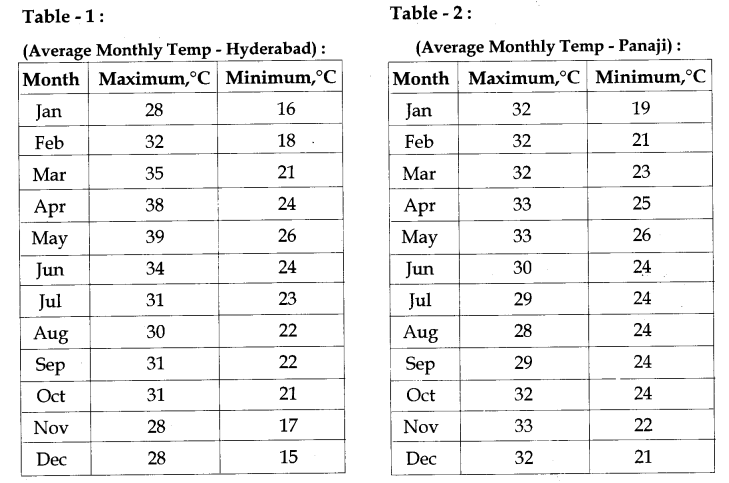
Answer:
The highest temperature in Table 2 is 33°C. The lowest temperature in Table 1 is 15°C. The difference between them is 18°C.
Question 3.
Suppose, the temperature in Moscow was -8°C at lOAM on 6 December. Twenty- four hours later, it was 12°C higher. What was the temperature at 10 AM on 7 December (information skills)
Answer:
7 December at 10 AM = 12°C higher
6Decemberatl0AM = -8°C
7 December at 10 AM -8 + 12 = 4°C
Question 4.
Delhi and Mumbai are both situated on plains and their height above sea level is less than 300 meters. Why is there so much difference in their monthly average temperaturesi In which months are the average temperatures in these two cities most similar Can you explain’ (Conceptual understanding)
Answer:
There is so much difference in the month1’s average temperatures of Delhi and Mumbai because Mumbai has a moderate climate while Delhi experiences extreme climate. This is because Mumhai’s coastal nature and tropical location ensures moderate temperatures throughout the year.
Delhi’s distance from the sea gives it an extreme type of climate known as continental climate. In the months of August and September, average temperatures in these two cities are found to be most similar due to monsoon is active.
![]()
Question 5.
Given below are the average monthly minimum and maximum temperatures of Jodhpur. Make a line graph of them. Which are the hottest and coldest months of the year? (Information skills)
Table: Average Monthly Minimum and Maximum Temperatures in Jodhpur, Rajasthan (°C)

Answer:
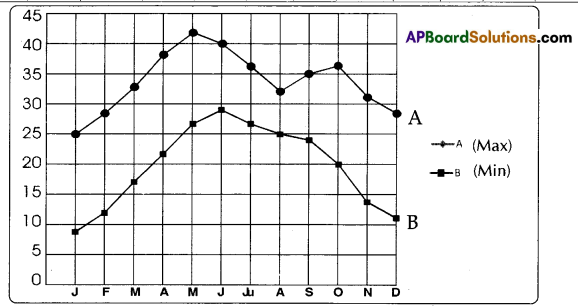
Line graph of average monthly minimum and maximum temperatures of Jodhpur The hottest month of the year is May (42°C). The coldest month of the year is January (9°C).
Question 6.
Given here are the average maximum temperatures of three places: A, B arid C. Make graphs of them. What can you guess about each place by looking at the Table and graphs? (Information skills)

Answer:
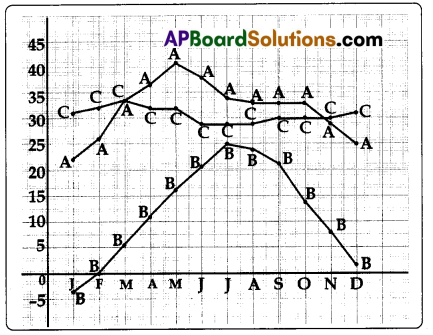
Line graph of are near maximum temperatures of three places A. B and C.
We can observe the following points from the graph and table.
- Highest temperatures are recorded in place A. This place is situated in continental type of climate. It is also known as extreme climate.
- Lowest temperatures are recorded in place B. This place may be a hill station.
- The temperature remains almost same throughout the year in place C. Hence it may be located on the seashore. it is known as moderate climate.
- Places A and C are situated more near to the equator than place B.
- Place B is cooler when compared to places A and C.
Question 7.
Give three possible explanations for the differences between the average temperatures in Thiruvananthapuram and Shimla in January (refer to your Atlas). (Mapping skills)
Answer:
- Thiruvananthapuram is on the seashore. Places near the sea usually have temperatures that remain fairly constant. Shimla is far away from sea. So, it does not experience moderate climate of Thiruvananthapuram.
- Shimla is on high altitude at an elevation more than 2000 metres above sea level. Thiruvananthapuram is on sea shore with less than 100 metres above sea level. Usually, for every 1000 meters increase in elevation, the temperature falls by about 6°C.
- Inversion of temperature is also one of the causes.
Question 8.
Between Bhopal, Delhi, Mumbai, and Shimla, which two places show a similar temperature pattern? How can you explain the similarity between these two places? (Conceptual Understanding)
Answer:
The places Bhopal and Delhi show a similar temperature pattern. They both are far away down ea with a continental type of climate.
Question 9.
Look at the graph of Minimum-Maximum temperature on the right and answer the questions below: (information skills)
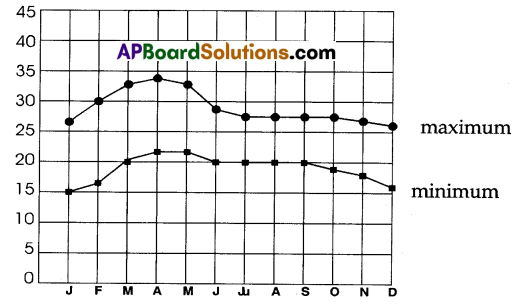
a) What is the average highest temperature in July?
Answer:
28°C
b) How warm does It usually gel in December?
Answer:
26°C
c) How cool does it usually get in June?
Answer:
20°C
d) Is there a bigger difference between night and day temp. in May or in August?
Answer:
May The difference between the temperatures of day and night in May are 33°- 22° 11°C. The difference between the temperatures of day and night in August are 28°-20° = 8°C.
e) When is summer?
Answer:
March, April, and May months.
Question 10.
How is solar energy better than thermal power? (Appreciation and Sensitivity)
Answer:
Solar energy is cheaper than thermal power. Solar energy is a renewable source of energy, unlike thermal power. Solar energy is pollution-free, unlike thermal power.
Question 11.
Read the para under the title “Height and Temperature” of page 27 and comment on it. (Reading the text (given), understanding and interpretation)
Height and Temperature:
At the peak of summer, some people go front the plains to hilly places such as Ooty or
Shimla to avoid the heat, Even in 11w summer months the temperatures are low on high
hills. The highest parts of a mountain generally have the lowest temperatures. Temperature decreases with elevation (height).
Look at the graphs showing the average monthly temperatures of Delhi and Shimla. You can sea quite clearly that in each month of the year, the temperature of Shimla is far lower than that of Delhi.
Delhi is at an elevation (height) of about 200 meters above sea level, while Shimla is at an elevation of about 2200 meters above sea level. Usually, fr every 1000 meters increase in elevation, the temperature falls by about 6°C. Due to cooler temperatures, different kinds of plants grow on high hill5 and mountains.

Answer:
Usually, for every 1000 meters increase in elevation, the temperature falls by about 6°C. That’s why hill stations like Ooty, Shimla, Araku, Horsely Hills have low temperatures even in summer. This is because temperature decreases with elevation.
On the other hand, places which are less in elevation above sea level show more temperatures compared to hill stations. Ex:- Delhi, Nagpur, etc. Due to this less temperature on hill stations, people prefer to go them in summer to avoid the heat.
Discussion:
The sun is the primary source of energy. The trees are the factories which produce food from sunlight. Are we growing or cutting down such trees? Discuss the advantages of trees and our responsibility in growing them.
Answer:
Ram nowadays, all the countries are worrying about global warming.
Niket: Yes. We, the humans are to be blamed. We have become so stupid to cut the branch on which we are sitting
Pallavi: All the living creatures are depending on plants and trees for food. The trees are the factories that produce food using sunlight. But, we are so selfish in removing trees.
Ram: Once, forests occupied major portion of the earth. There were timely rains, no diseases, no pollution. But for wood, habitation, for construction of industries, dams, slowly forests disappeared. Now, the ill – effects are being experienced.
Pailavi: Trees are lifelines. They take in the carbon dioxide exhaled by all creatures and give out oxygen. Trees help in causing rains, controlling atmosphere, maintaining ecological balance.
Reshma: One day, this earth becomes a big desert if the indiscriminate felling of frees continues.
Saroja: We have to plant trees. Movements like Chipko, Vana Mahotsahavam, Operation green zone have to be taken up on a war – footing. We have to make our future generations live happily on this beautiful planet with timely rains. It is possible only by planting trees.
![]()
Project:
Visit some families in your village/locality and fill up the following table.

Educate the families about the energy-saving measures and then conduct the same survey again after three months and compare the difference.
Answer:
I visited some families and gathered information about the electric bulbs used and bill charges.

Saving measures: After discussing with them. I noticed that most of the Families are not aware of l.ED bulbs. I explained them about how LED bulbs help in minimising the expenditure of electricity.
- Use LED bulbs: Governments are providing LED bulbs with subsidy. LED bulbs use less electricity, vet give good glow.
- Use LED bulbs and tube lights in the place of 40-watt, 60-watt filament bulbs. Ordinary bulbs are cheaper hut, tube lights, and LED bulbs cousume less power and give better glow than ordinary bulbs.
- Switch off Lights when not needed.
- Construct the houses and arrange the rooms in such a way that sunlight is utilised more.
I conducted the survey after 3 months. I felt happy that, the families paid attention to suggestions on saving electricity. They replaced LED bulbs in the place of ordinary bulbs. They adopted other measures like good wiring, putting off lights when not needed, etc. The electricity charges have come down considerately.
Intext Questions
Textbook Page No: 18
Question 1.
Have you been to places that have a different climate than where you live? Describe it in the class. (Appreciation and Sensitivity)
Answer:
I live in Hyderabad. I went to Ooty during summer vacation along with my family. I experienced a change in climatic conditions over there. The temperature in Hyderabad during summer was recorded as 40°C but in Oot-v it was just 12°C.
We were shivering with cold in Ooty whereas every year in Hyderabad it was very hard for us to survive without A.C. during summer. I have also been to Shimla, Kodaikanal, and Darjeeling earlier. I noticed a drastic change in the climatic conditions in these places when compared to my home city, Hyderabad.
Question 2.
You know that the Sun is the source of heat on the Earth. But why do you think the heat vanes from morning to night or from season to season and front place to place? We are listing some variations here. Try to think a reason for it and discuss in the class before you proceed to read this chapter. (Reflection on contemporary issues and questioning)
1. Cool in the early morning and warmer in the afternoon.
Answer:
The sun rays fall slantly in the morning, whereas their fall is vertical during the afternoon.
2. Warm in summer and cool ¡n winter.
Answer:
The fall of sun rays is vertical during summer and they fall silently during winter and the rotation of the earth brings it to closer to the sun during summer than the winter.
3. Cool on hilltops and warm in the plains.
Answer:
Temperatures reduces 6°C for every 1000 mts above the mean sea level. So, it is cool on the hilltops and warm in the plains.
4. Warm in equatorial region and cold in Polar region.
Answer:
- The Sun rays fall vertically and at the right angle of 90” on the equator. They spread on a limited area.
- The polar regions experience the slanty fall off of Sun rays and spread over a large area. So, the temperatures are cool.
Textbook Page No: 19
Question 3.
Can you point out the difference between insolation and radiational (Conceptual understanding)
Answer:
I leat and light energy coming from the sun is known as radiation whereas insolation is the solar radiation received by the surface of the earth.

Question 4.
What will happen if the atmosphere gets more polluted with smoke and dust? (Reflection on contemporary issues and questioning)
Answer:
If the atmosphere gets more polluted with smoke and dust, then more amounts of solar rays will be absorbed or reflected by the smoke and dust. Hence, the earth becomes hotter and it is very difficult for plants and animals to survive.
Textbook Page No: 20
Question 5.
Where will the rays fall more slanting – in Japan or North Pole? (Conceptual unders taniling)
Answer:
North Pole.
Question 6.
Where will Sun’s rays fall more intensively, in Telangana or Rajasthan? (Conceptual understanding)
Answer:
Rajasthan.
Question 7.
If the Earth was flat and not curved, then which will place would get more heat – Japan or the Equator, or both equally? (Conceptual understanding)
Answer:
Both equally.
![]()
Question 8.
Look at the globe and find out which countries will be holler and which will be cooler?
Answer:
Hotter countries: Kenya, Indonesia, P’rt of Mexico, Namibia, Chili, Africa.
Cooler countries: Canada, Part of Russia, Greenland, Ireland, North America, etc.
Textbook Page No: 21
Question 9.
Can you tell why there is difference in heating of land and water? (Conceptual understanding)
Answer:
Water has a higher capacity for storing heat than does land surfaces. This means that the same amount of solar radiation will heat up the ground more than it will the ocean. In addition, heat absorbed by the oceans is distributed, through mixing, over a greater depth than the heat absorbed bland surfaces. So in the summer, when the amount of solar radiation is highest, the difference between the land and ocean temperatures is highest.
This causes the air over the land to heat up and expand causing it to become less dense and rise. This rising air is then replaced with neighbouring moisture rich in air from over the ocean’s surface resuinrig in a sea breeze.
Text Book Page No. 23
Question 10.
To get an idea of other temperatures, measure and note the temperature of the following things. Before you start measuring, guess the temperature of each one. (Information skills)
| Thing | Temperature, °C | |
| Guess | Measurement | |
| Water in bucket | 27°C | 35°C |
| Ice | 0°C | 3°C |
| Glass of cold water | 15°C | 10°C |
| Warm bath water | 50°C | 55°C |
Question 11.
It is safer and advisable to use thermometers that have a scale of 10°C to 110°C. Using such a thermometer, also measure and note the temperature of boiling water and hot tea. (Conceptual understanding)
Answer:
Temperature of boiling water = 100°C.
Temperature of hot tea around = 96°C.
Question 12.
For the next one week, measure the air temperature each day at the same time and place (Remember to choose a place that is in the shade). Each day before you measure, write down your guess, keep your record in a separate notebook.
Answer:
Place: ………………………..
Month: ………………………..
Time: ……………………….. (Information skills)
| Date | Air Temperature,°C | |
| Guess | Measurement | |
a. Record the temperature every day for one week for a few months.
Answer:
Place : Thiruvananthapuram
Month: January 2017
Time: 12.00 noon
| Date | Air Temperature, °C | |
| Guess | Measurement | |
| 01-01-2017 | 28°C | 31° |
| 02-01-2017 | 29°C | 31° |
| 03-01-2017 | 27°C | 31° |
| 04-01-2017 | 26°C | 30° |
| 05-01-2017 | 27°C | 30° |
| 06-01-2017 | 28°C | 30° |
| 07-01-2017 | 29°C | 30° |
b. Calculate the weekly average temperatures. (Conceptual understanding)
Answer:
The average temperature recorded in the week of January.
= \(\frac{31+31+31+30+30+30+30}{7}=\frac{213}{7}\) = 30.42°C
c. Discuss the variations between different weeks. (Conceptual understanding)
Answer:
Thiruvananthapuram experiences a moderate type of temperature. There is no significant differences to be noted. It is due to the close distance from the Arabian sea. This type of climate is termed ‘Maritime climate’.
Text Book Page No. 24
Question 13.

a. Which temperature is higher: 5°C or -5°C?
Answer:
5°C.
b. At which of these two temperatures will we feel colder?
Answer:
-5°C.
c. How many degrees difference is there between -5°C and 5°C?
Answer:
10°C
d. Write in short forn ‘ach of the following temperatures:
a) 88 degrees below zero, Celsius
Answer:
88°C
b) 38 degrees above freezing. Celsius
Answer:
38°C
c) 32 degrees below freezing, Celsius
Answer:
-32°C
Question 14.
Did you note the temperature in your classroom today? 88 degrees below zero Celsius is how many degrees lower than the temperature you measured?
Answer:
The temperature in my classroom today is noted as 30°C. 88 degrees below zero Celsius is (88 + 30) 118°C degrees lower than the temperature of the classroom
Question 15.
The temperature of a normal human body is 37°C. How much hotter than normal body temperature is 50°C?
Answer:
13°C.
Question 16.
How much colder than the normal body temperature is -5°C?
Answer:
42°C.
Question 17.
Arrange the following temperatures from the highest to the lowest: 12°C, -16°C, 29°C, 0°C, -4°C.
Answer:
29°C, 12°C, 0°C, 4°C, -16°C.
Question 18.
At which of the above temperatures will we feel the hottest?
Answer:
29°C
Question 19.
At which of the above temperatures will we feel the coldest?
Answer:
-16°C
Text Book Page No. 24 and 25
Question 20.
Look at the data and the graph and answer the following questions about Hyderabad. (Information skills)
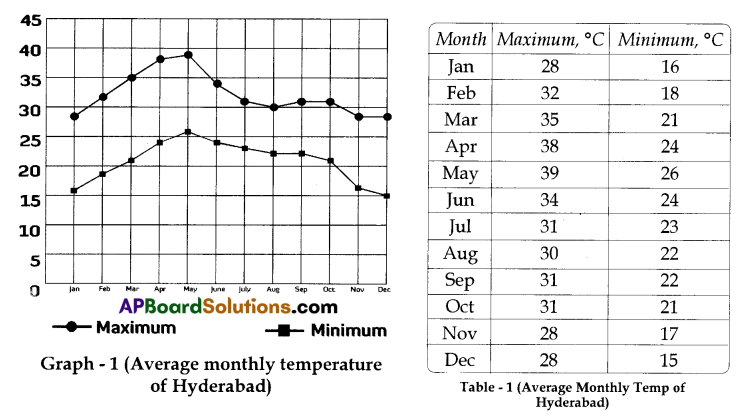
a. How cold does it usually get in November in Hyderabad?
Answer:
17°C
b. Which month has the highest maximum temperature in Hyderabad’
Answer:
May (39C Maximum.)
![]()
c. What is the difference between the highest maximum temperature and the lowest minimum temperature in the year?
Answer:
Highest maximum temperature is 39’C and lowest minimum temperature is 15°C. The difference between them is (39.15) 24°C.
d. Which three months are the hottest in Hyderabad?
Answer:
March. April and May.
e. Which three months are the coldest?
Answer:
November, December, and January.
f. What is the average maximum temperature in January in Hyderabad
Answer:
28°C.
g. From June through December, the average minimum monthly temperature keeps falling in Hyderabad. Does the average maximum monthly temperature also keep falling?
Answer:
Yes.
h. What is the difference between the maximum and minimum temperature in May?
Answer:
13°C. (39°C – 26°C)
i. What is the difference between the maximum and minimum temperature in August?
Answer:
8°C, (39°C-22°C)
j. Based on your answers to the above two questions, ¡s there a larger difference between the maximum and minimum temperatures in the summer or in rainy season in Hyderabad?
Answer:
The difference between maximum and minimum temperatures is 13°C in summer but the difference between maximum and minimum temperatures in rainy season is 8°C. So, summer is a larger difference between the maximum and minimum temperatures.
Question 21.
Study the following table and answer the questions. (Information skills)
Table 2: Average monthly temp. of Panaji
| Month | Maximum,°C | Minimum, °C |
| Jan | 32 | 19 |
| Feb | 32 | 21 |
| Mar | 32 | 23 |
| Apr | 33 | 25 |
| May | 33 | 26 |
| Jun | 30 | 24 |
| Jul | 29 | 24 |
| Aug | 28 | 24 |
| Sep | 29 | 24 |
| Oct | 32 | 24 |
| Nov | 33 | 22 |
| Dec | 32 | 21 |
a. Which month has the lowest minimum temperature in Panaji? How much is it?
Answer:
January, 19°C.
b. Which is the hottest month in Panaji?
Answer:
April, May and November are the hottest months in Panaji.
c. How much was the average maximum temperature for that month?
Answer:
33°C.
Text Book Page No. 27
Question 22.
Compare the temperatures of Hyderabad and Panaji to answer the following: (Information skills)
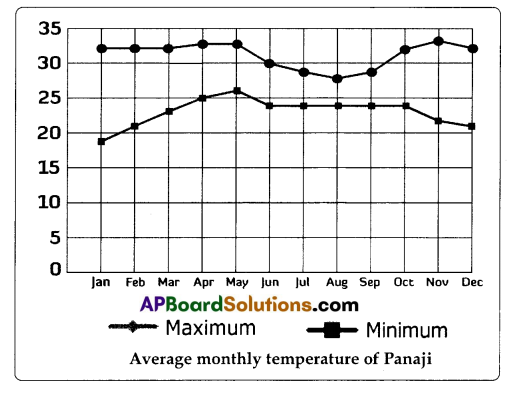
a) In January, which place is colder?
Answer:
Hyderabad
b) In June, which place is hotter?
Answer:
Hydera bad
c) In which place. Hyderabad or Panaji, does the temperature remain more or less the same throughout the year?
Answer:
The temperature remains more or less the same throughout the year in Panaji.
Text Book Page No. 27 – 28
Question 23.
Look at the graphs showing the average monthly temperatures of Delhi and Shimla. You can see quite dearly that in each month of the year, the temperature of Shimla is far lower than that of Delhi. (Information skills)
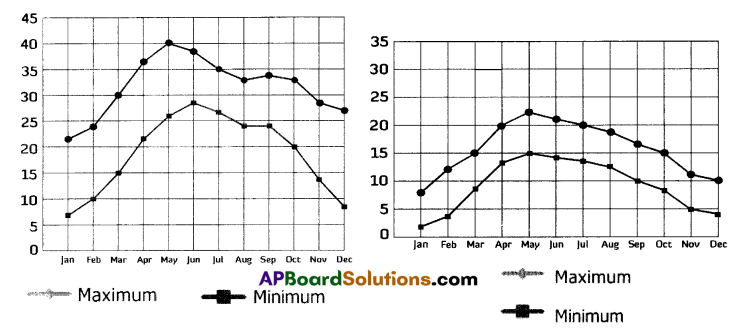
a. Can you think of any other reason for this kind of temperature?
Answer:
- High altitude of the areas.
- Forest coverage.
- Nearness to sea shore.
b. What will happen if the inversion occurs?
Answer:
When version occurs, cold air underlies warmer air at higher altitudes. Cool temperatures are found near the ground on winter mornings and dew drops on the grass are also seen.
c. How many meters higher than Delhi is Shimla?
Answer:
Delhi is at an elevation of about 200 meters above sea level while Shimla is at an elevation of about 2200 metres above sea level, Shimla is 2000 metres higher than Delhi.
d. Based on the difference in elevation, calculate the likely difference in
temperature between two places.
Answer:
For every 1000 metres increase in elevation, the temperature falls by about 6°C. Hence the difference in temperature between Shimla and Delhi must be around 12°C.
e. Which month has the highest maximum temperature in Shimla? How much is the temperature?
Answer:
May, around 22°c.
f. Which month has the highest maximum temperature in Delhi? How much is it?
Answer:
May, 40°C.
g. In September, the average naumum temperature in Shimla is ……………. °C while in Delhi, it is ……………….°C.
Answer:
17°C, 34°C.
h. Which is colder: Delhi in January or Shimla in July?
Answer:
Delhi in January.
Question 24.
Find out the locations of Singapore, Shanghai and ‘Vladivostok on the above picture of the globe. (Sapping skills)
Answer:

Text Book Page No. 29
Question 25.
Average maximum monthly temperatures of Singapore, Shanghai & Vladivostok.

a. Which of the three places shown in the graph is located nearest to the Equator? (Information skills)
Answer:
Singapore.
b. What is the average yearly temperature in that place?
Answer:
27.8°C
![]()
c. Does it usually get much warmer in the summer than in the winter there?
Answer:
yes. It is much warmer In summer than In th winter.
d. Is summer in Vladivostok warmer than the winter in Singapore?
Answer:
No.
e. Does it usually get warmer in July in Singapore or in Shanghai?
Answer:
Shanghai.
f. Which of the three places on the graph has the most extreme climate?
Answer:
Singapore.
g. What is the warmest month in Shanghai?
Answer:
August.
h. What is the average yearly temperature there?
Answer:
15.3°C.
i. Which month has the lowest average maximum temperature in this place?
Answer:
January,
Question 26.
Use the maps in your Atlas to find out the latitude and the average temperature in January of each of the following places: The first one has been done for you.
| Place | Latitude | Temp. in January |
| Hyderabad, T.S | 17 ° N | Between 200 and 225°C |
| Agra. U.P | ||
| Madurai, T.N, | ||
| Nagpur, MH |
Answer:
| Place | Latitude | Temp. in January |
| Hyderabad, T.S | 17N | Between 20° and 22.5°C |
| Agra, U.P | 27.1833° N | Between 7.7° and 22.3°C |
| Madurai, EN | 9.9300° N | Between 20.1° and 30.5°C |
| Nagpur, MH | 21.1438° N | Between 12.4° and 28.6°C |
Question 27.
Look in your Atlas to find shows the average (mean) temperatures in January. (Mapping skills)
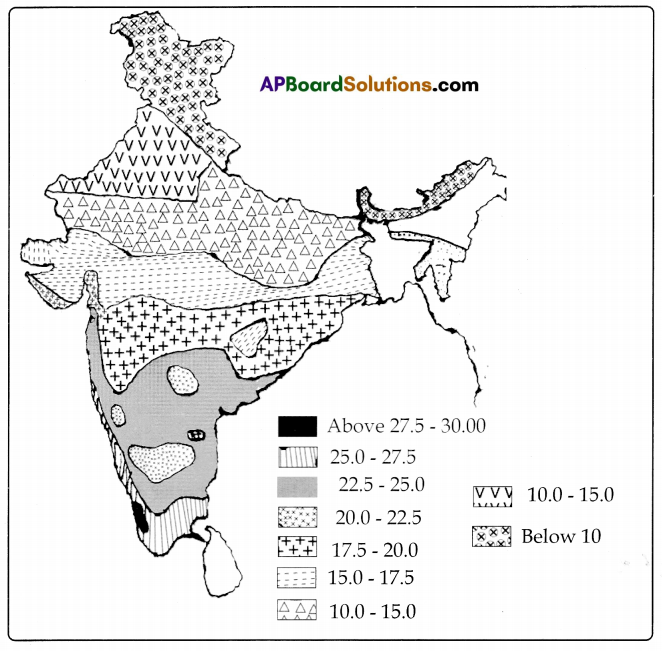
a) Look at the map and find out which parts of India that usually have the highest average temperature (in January).
Answer:
Kerala and it adjacent parts of Tamilnadu and Karnataka.
b) If you look north from this place on the map. is the average January temperature higher or lower?
Answer:
Lower.
Text Book Page No. 30
Question 28.
Look at the following table. It shows the time of sunrise and sunset in different cities in India on 10th January. Answer the questions below. (Information skills)
| Place | Sunrise | Sunset |
| Hyderabad, A.P | 6:49 | 5:58 |
| Agra, U.P | 7:09 | 5:42 |
| Madurai, T.N | 6:37 | 6:12 |
| Nagpur, MH | 6:53 | 5:48 |
| Visakhapatnam (A.P) | 6:29 | 5:38 |
| Kohima (Nagaland) | 6:02 | 4:40 |
a. In which of these six cities does the sun rise first?
Answer:
Kohima (Nagaland)
b. In which of these cities does the sun set last?
Answer:
Madurai (Tamil Nadu)
c. How long is the daytime in each of the six cities? (The daytime is the number of hours between sunrise and sunset).
Answer:
Hyderabad – 11 hours 9 minutes.
Agra – 10 hours 33 minutes.
Madurai – 11 hours 35 minutes.
Nagpur – 10 hours 55 minutes.
Visakhapatnam – 11 hours 7 minutes.
Kohima – 10 hours 38 minutes.
d. Do the cities that are farther north have longer or shorter daytimes than the cities to the south?
Answer:
The cities in farther north have shorter da times than tIic cities to the south.
e. Based on your answers to the above questions, can you think of why the north of India remains cooler than the south in winter?
Answer:
The night durations are more in north India which make the temperatures. cooler than that of South.
The following are reasons for North India to be cooler.
1. The cool winds.
2. The lar distance of north India from oceans.
3. The high altitude of North India.
Question 29.
Read the paragraph ‘The Sun is the principal source of energy we can neither feel nor see’ about Solar energy and Sun’s rays of page no.s 18 and 19. Write the content in your own words.
The Sun is the principal source of parergon the Earth’s surface. it is like a powerhouse
which generates and gives out energy in tire form of light and heat. This energy constantly
emitted by the sun is known as solar radiation. When a body gives out energy it is called radiation.
The energy produced by the Sun comes to us in the form of sun’s rays. Some aspects of this energy we can see and feel, like light and heat. However also receive many of lier forms of energy like UV rays, radio waves, x-rays, radio waves the sun which we can neither feel nor see.
Answer:
- The sun is the principal source of energy that gives light and heat in the form of rays.
- This sun’s energy is known as solar radiation.
- We receive many other energy forms like U’ rays, radio waves, X rays also from the sun but we can neither feel them like heat nor sec them like light.
Question 30.
Read the paragraph “Panaji” is on seashore ……………. ” and answer the following question.
Panaji is on the seashore! it s difficult for the sun to heat rip or cool down the sea. Since the sea doesn’t get too hot or cold, the air above tire sea also doesn’t get too hot or cold. Therefore places near the sea usually have temperatures that remain fairly constant throughout the year. They have what is known as a moderate rote climate. Why does the temperature in Panaji not change much throughout the year?
Answer:
1. The places which are near the sea usually have temperatures that remain fairly constant throughout the ‘ear. For example, a station loçatI on the sea is cooler during the summer and warmer during the winter when comprared to a station situated at a distance from the sea. The temperature in Panaji does not change much throughout the ‘ear. Because Panaji is on the seashore.
Question 31.
Read the paragraph The temperature distribution ………………. and answer the following question.
The temperature distribution, over land and oceans, is much different and varying. This will be very clear if you rna’asun’ (record) temperatures of places over continents and oceans. Land is considered as good conductor of heat, whereas water bodies are different. While land gets heated and cooled quickly, oceans will take lime to heat and cool. What is the relative distribution of land and water?
Answer:
The land mass reheated up and cooled down quickly, when compared to the water bodies. Hence, the land masses and the water bodies, though positioned on th same latitude, record different temperatures.
Mapping Skills
A. Mark tlwfollowiug places on India map.
1. Shimla
2. Pana
3. Delhi
4, Mumbai
5. Ooty

B. Mark the following on India Map.
1. Hyderabad
2. Agra
3. Madhurai
4. Nagapur

Information Skills
A. Study the following table and answer the questions that follow.
| Topic | Definition |
| 1. Height and Temperature | At the peak o summer, some people go from the plains to hilly places such as Ooty or Shimla to avoid the heat, Even in the summer months the temperatures are low on high bilk, The highest parts of a mountain generally have the lowest temperatures Temperature decreases with elevation (height). |
| 2. Heating of the Atmosphere | You may be surprised to know that the atmosphere or the air around us is not heated directly by the rays of the Sun. In fact it allows the rays to pass through without being heated by them The Sun rays first heat the Earth’s surface. This in turn begins to radiate heat which heats up the air around us. That is why it is warmer near the surface of the Earth compared to higher reaches of the atmosphere. |
a. Where do people go to avoid heat?
Answer:
Ooty or Shimla
b. Temperature decreases with ……………. .
Answer:
Elevation.
c. What do the Sun rays heat first?
Answer:
Earth’s surface
d. Why is it warmer near the surface of the Earth compared to higher reaches of the atmosphere?
Answer:
The Sun’s rays first heat the Earth’s surface, This in turn begins to radiate heat which heats up the air around us. That is why it is warmer near the surface of the Earth compared to higher reaches of the atmosphere.
B. Read the given paragraph below and answer the following questions.
Some gases like carbon dioxide pProent radiation of heat from the earth. Carbon dioxide
in the atmosphere increases due to increased use of diesel and petrol. cutting down of forests etc. If the carbon dioxide proportion in the atmosphere increases then less heat be radiated causing an increase in global temperatures. This results in what is called ‘Global Warming’.
1. Name the gas mentioned in above passage.
Answer:
Carbon dioxide.
2. When did carbon dioxide increase in the atmosphere?
Answer:
Atmosphere increases due to increased in use of diesel and petrol, cutting down of forests.
3. What is called ‘Global warming’?
Answer:
An increase of carbon dioxide in atmosphere causes increase in global temperatures. This is known as Global warming.
4. What are the fuels mentioned in the passage?
Answer:
Petrol and diesel.
One mark Questions
Question 1.
Who is the principal source of energy?
Answer:
The Sun.
Question 2.
What is solar radiation?
Answer:
The energy constantly emitted by the Sun is known as solar radiation.
Question 3.
What is meant by ‘insolation’?
Answer:
The solar radiation received on the surface of the Earth is called ‘insolation’.
Question 4.
Which gas prevents radiation of heat from the earth?
Answer:
Carbon dioxide.
![]()
Question 5.
What does mean by Global Warming’?
Answer:
If the carbon dioxide proportion in the atmosphere increases, then less heat will be radiated causing an increase in global temperatures. This is known as Global warming.
Question 6.
What is the capital city of Goa?
Answer:
Panaji.
Question 7.
What is height of Delhi from sea level?
Answer:
Delhi is at an elevation of about 200 metres above sea level.
Question 8.
What do you know about ‘angle of incidence’?
Answer:
The angle at which the rays fall on the earth surface is known as angle of incidence.
Question 9.
When does carbon dioxide increase in the atmosphere?
Answer:
Carbon dioxide in the atmosphere increase due to increased use of diesel and petrol, cutting down of forests etc.
Question 10.
Name one of the African country which is nearest to the Equator.
Answer:
Nigeria.
Objective Type Questions
Question 1.
About …………………. of the solar energy is reflected back by the Earth’s atmosphere. ( )
A) 1/2nd
B) 1/3rd
C) 1/4 th
D) 1/5 th
Answer:
B) 1/3rd
Question 2.
The angle of incidence increases in the north during the months of ( )
A) May, June
B) January, February
C) November, December
D) March, April.
Answer:
C) November, December
Question 3.
Some gases like …………….. prevent the radiation of heat from the earth. ( )
A) Oxygen
B) Carbon dioxide
C) Nitrogen
D) Helium
Answer:
B) Carbon dioxide
Question 4.
At Vostok station, In the Antarctica, the temperature fell to in July 1983. ( )
A) -89°C
B) -90°C
C) -91°C.
D) -92°C.
Answer:
Question 5.
For every 1000 meters increase in elevation, the temperature falls by about ( )
A) 4°C
b)5°C
C) 6°C
D) 9°C
Answer:
C) 6°C
Question 6.
The solar radiation received on the surface of the earth is called ( )
A) Radiation
B) Insolation
C) Reflection
D) Angle of incidence
Answer:
B) Insolation
Question 7.
Identify the False statement about ‘Green houses’ ( )
A) Creating artificial environment for plants.
B) Building houses in very hot regions.
C) Growing vegetables and fruits.
D) Those buildings are with transparent roofs and walls to allow heat.
Answer:
C) Growing vegetables and fruits.
![]()
Question 8.
…………… of the solar energy is reflected back by the earth’s atmosphere. ( )
A) One third
B) Two third
C) Three fourth
D) None of these
Answer:
B) Two third
Question 9.
If the insolation received at the Equator is 100 units then ……………….. . ( )
A) 75 units insolation at 45°.
B) 5o units insolation at 66½°.
C) 40 units insolation at 900.
D) All of these.
Answer:
B) 5o units insolation at 66½°.
Question 10.
Amount of insolation reflected by clouds in the total insolation (100%) is …………………… . ( )
A) 6%
B) 51%
C) 20%
D) 16%
Answer:
B) 51%
Question 11.
Which month has the highest maximum temperature in Hyderabad? ( )
A) March
B) May
C) July
D)January
Answer:
B) May
Question 12.
What is the difference between the highest maximum temperature and the lowest maximum temperature in the year? ( )
A) 39°C
B) 15°c
C) 28°c
D) 24°c
Answer:
B) 15°c
Question 13.
………………… degrees difference is there between – 5°c and 50? ( )
A) 10
B) 5
C) 0
D) 15
Answer:
A) 10
Question 14.
Arrange the temperature from the highest to the lowest. 12°c. 16°c, 0°c, – 4°c, 29°c ()
A) 29°c, 4°c, 0°c, -16°c,12°c
B) 29°c, 12°c, 0°c, 4°c, -16°c
C) -16°c, 4°c, 0°c, 12°c,29°c
D) 0°c, 12°c, 29°c,- 4°c, -16°c
Answer:
B) 29°c, 12°c, 0°c, 4°c, -16°c
Question 15.
38 degrees below freezing, celcius ( )
A) 38°c
B) -38°c
C) 33°c
D) -33°c
Answer:
C) 33°c